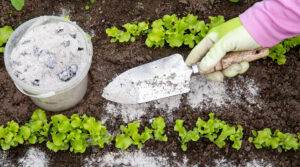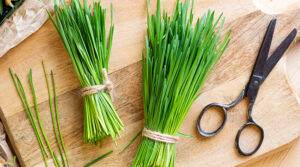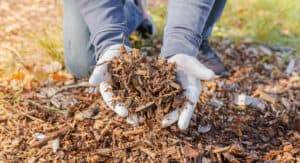What is Mulch?
Mulch is any material used to cover the ground in a garden, farm, or landscaping scenario. These materials differ widely in their cost, organic make-up, heft, and carbon footprint. From straw to cardboard to grass clippings, various types of mulch can be used in different contexts to best serve your needs and purposes.
Purpose and Benefits of Mulch
Moderates Soil Temperature
Think of mulch as an insulative Winter blanket that keeps your garlic bulbs, your tulips and daffodils, from full-on freezing in the coldest of times. It’s true that the earth itself provides insulation, but a covering of mulch evens out the most extreme temps, which lowers the stress on the dormant or newly emerging plants.
This same phenomenon is true in the opposite direction come Summertime. A covering of straw on your potato patch or leaves surrounding a new kale planting can help to keep soil temperatures cool in the hotter months. Keep in mind that heat-loving plants like tomatoes or peppers may not appreciate this cooling effect, especially in the early stages of their growth.
Weed Suppression
Mulch can be used to great effect in keeping the weeds down in any planting, regardless of scale. A thick layer of wood chips at the base of your fruit tree will prohibit weeds from taking root and competing for water and nutrients. Those same wood chips in the path of your herb garden will minimize the amount of weeding you need to do in the space. Farms large and small make use of mulch within their vegetable beds to combat the growth of weeds and keep labor costs down.
Retains Moisture/Erosion Control
On our farm in Michigan, we are subject to more and more volatility in the weather – particularly fluctuations between extreme rain events and extreme drought. Mulching has acted as a helpful buffer for both. It prevents water from evaporating off of the surface of the soil, keeping it right where we want it. And it also protects our soil from being washed away in a downpour. As the challenges of climate change become more serious, mulch really can be an effective moderating tool.
Nutrient Provider
Depending on their make-up and size, mulches break down at different rates. Eventually, however, all organic mulches have something to offer the soil in terms of nutrients. Consider the thick rich humus on the floor of a healthy forest, all of the leaves and needles that have fallen to the ground and decomposed over the years to create that depth. At its best, a mulched system seeks to mimic that forest floor.
Encourages Micro-Organisms and Beneficials
The happiest and fattest earthworms on our farm are hanging out underneath the mulch of our asparagus bed – an area whose soil has been covered with several inches of straw each year, and left undisturbed. In the same ways that plants benefit from the moderated soil temperatures and moisture levels of mulched ground, the microscopic (and slightly larger) lifeforms within our soil do, too. Mulch can also provide habitat to other creatures, some of whom can be really beneficial to the garden (toads, spiders, snakes) and some of whom might not be so helpful (snails, slugs, voles).
Minimizes Disease
A layer of mulch can be just the ticket in preventing the splash-up of soil borne diseases onto more vulnerable plants like tomatoes and cucumbers. This can keep various blights at bay, and extend the life of your favorite vegetable plants.
Beautification
Mulch can make an area look more tidy and kept, if that’s what you’re going for. It can also just help a space feel more user-friendly, defining edges, borders, and pathways.
Types of Mulch Used for Vegetable Gardening
Straw
PROS: Straw is readily available, fairly cheap, and effective. It can be purchased in amounts to suit a wide range of project scales. We love it for mulching our garlic and potato patches, and have been expanding our use of it for other crops on the farm.
CONSiderations: Be conscious of herbicide use or residue when procuring straw. Organic straw can be difficult to find; it’s always good to ask questions of your farmer/supplier. Straw may also invite pests like slugs and snails, and provide a cozy place for mice and voles to nest in.
Grass Clippings
PROS: We regularly use grass clippings to mulch our onion beds. A one-inch layer goes a long way, as the grass tends to bind together and form a sort of mat. Grass clippings are a great way to close the loop on the inputs you need to acquire.
CONSiderations: Too thickly applied, grass clippings are “hot” – literally. They’re high in nitrogen, and produce a lot of heat as they decompose. Experiment with thinner layers, and try to use dry clippings if you can.
Woodchips
PROS: Another readily-available resource! We use an app called Chipdrop that connects arborists with people looking for woodchips for little to no cost. It’s a fantastic way to repurpose something discarded into something valuable. Woodchips are attractive, easy to apply, and add a wealth of nutrients back to the soil over time.
CONSiderations: Context and type are both important in the selection of woodchips as mulch. While they are providers in the long-term, this carbonaceous material can leach nutrients from the soil at first. While we use woodchips in the pathways of our farm, we take care to keep them away from the edges of the vegetable beds (raised beds can be a great solution here). Be sure you know which species of wood you are using. A chemical in Black Walnut, for example, is known to inhibit the growth of other plants.
Leaves/Leaf Mold
PROS: Tree roots are able to mine deep within the soil, extracting nutrients and minerals in a way most other plants simply can’t. This makes their leaves a very rich addition as mulch. As they decompose and rot, they crumble beautifully, attracting and feeding all kinds of microorganisms. Our leaf pile is consistently loaded with earthworms. Leaves are easy to collect – and, if you’re resourceful, you can collect them from others’ homes, too!
CONSiderations: Wet leaves sometimes form their own kind of impenetrable mat that doesn’t allow for air or water to get through. Shredding the leaves beforehand is a good way to get around that. Just as with woodchips, the leaves of certain species of trees are also toxic. Be sure you know what you’re getting!
Compost
PROS: Using compost as a mulch gives you the added advantage of having a surface that’s ready to plant right into! Meanwhile, it’s still offering the same benefits of reducing erosion, moderating temperature and moisture, and certainly providing nutrients.
CONSiderations: Not all compost is created equally. If not brought to the proper temperature, compost can harbor both weed seeds and pathogens. Get your compost from a source you trust, or try making your own.
Pine Needles
PROS: Pine needles are light, abundant, attractive, and easy to move.
CONSiderations: Pine needles are acidic, and can alter the pH of the soil over time. Consider using this to your advantage by using them to mulch acid-loving plants like blueberries and azaleas.
Cardboard/Newspaper
PROS: One man’s recycling is another man’s treasure! Cardboard and newspaper both work wonderfully to smother weeds. Often, these materials are used to establish a new planting area within a no-till system. Our favorite application of cardboard mulch is to clear weeds and grass from the fenceline of our farm. We mow the grass low, put a thick layer of cardboard down, and then follow that with four to six inches of woodchips. It’s very effective.
CONSiderations: Be sure to check cardboard for tape, glues, and staples. It can be cumbersome, flap up in the wind, trip up the wheelbarrow. Bring your patience to cardboard laying day.
Living Mulch/Cover Crops
PROS: Living mulches are as dynamic as their name suggests. Different plants or combinations of plants will serve different purposes, whether it’s attracting pollinators, acting in competition with weeds, or drawing up nutrients from the soil. Some practical applications of living mulches include living pathways in your garden, a ground cover as part of a guild, or a corridor between large plantings of trees (i.e. an orchard).
CONSiderations: Because they are alive, these mulches require some management – or they can get out of hand. We tried red clover as a living pathway in our garden, and it quickly began to creep into the vegetable beds themselves. This can be managed by regular mowing, the grazing of animals, or the selection of annual plants.
Rocks, Gravel, Landscape Fabric, Synthetics
PROS: These materials all tend to last well longer than their organic counterparts. They can look more managed and tidy, too. And most are quite easy to procure from a garden center or landscaping business.
CONSiderations: Inorganic mulches will not benefit your soil in the ways organic mulches do, and, in fact, they could cause harm. Mulches containing dyes or plastics can potentially leach toxins into the soil. Be informed about your materials, and consider not only your health, but the health of the earth.
How to Apply Mulch in the Garden and Around Trees
The methods and means by which you apply mulch are all pretty dependent on the material you choose.
These things hold true:
1) Organic mulches will likely need to be reapplied every year or two.
2) Keep mulch away from plant stems and tree trunks. Close contact can cause them to rot. There are exceptions here (garlic comes to mind), but it’s a good rule of thumb.
3) The best time to apply mulch is in the Spring, before weeds have begun germinating. There’s no wrong time per se, but that timing will definitely make your life easier.
4) Mulch materials that are chopped finely and/or well-aged will decompose more quickly and make a faster contribution of nutrients to the earth. They are also less likely to leach nitrogen from the soil.
5) Mulching depth varies by material and what plants you’re spreading it around. In general, 4-6” is adequate. Less than that, and weeds tend to find their ways through. Grass clippings are an exception; shoot for 1-2” maximum. Sometimes it pays to be patient, and let your plants put on some size before mulching around them.
Special Mulching Techniques
Sheet Mulching AKA Lasagna Gardening
This method is basically an in-place compost pile that, once it slowly breaks down, can be planted right into. Cover a tightly-mowed piece of ground with cardboard, and water the area well. This will keep the cardboard in place and begin its decomposition. Now, lay a 2″ layer of carbon-rich material: straw, leaves, newspaper etc. Follow that with a 2″ nitrogen-rich layer: grass clippings, rotted manure, kitchen scraps, etc. Alternate these layers back and forth until you reach a height of about 3′. There’s no need to turn this pile. It will compost in place, compress down, and be ready for planting within a few months to a year.
Less intensive (and faster!) versions of sheet mulching make use of the cardboard layer for weed suppression, but put only a thick layer of compost on top. This can be planted directly into, and seems a very successful method for a crop like garlic.
Chop & Drop
This is perhaps the easiest method of mulching out there. It’s the process of cutting back leafy plants and using those nutrient-rich leaves as mulch. A classic example of this is in a permaculture guild setting: The leaves of the comfrey plant are chopped down to ground level and placed around the base of the fruit tree it’s planted next to.
Parting Thoughts
I’ve found as we get more creative with what we use as mulch and how we use it, a lot of doors begin opening in the realms of sustainability, permaculture, and resourcefulness. It’s a great first step into creating working systems within your growing spaces, and closing some input loops. Mulch is also a uniquely useful tool whose impact is immediate – not one to be overlooked!








